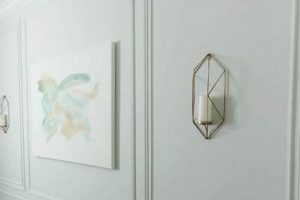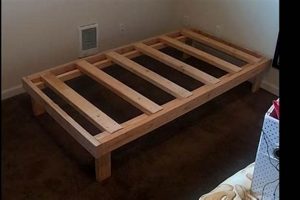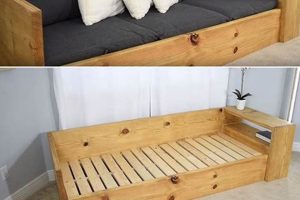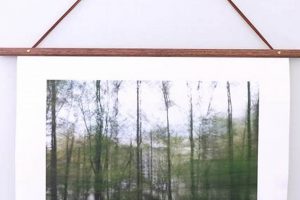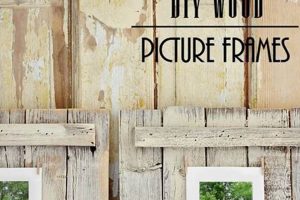A handcrafted border for photographic or artistic displays, often constructed from timber and assembled by the individual, provides a personal touch to home dcor. For example, an individual might select reclaimed lumber, cut it to specified dimensions, join the pieces with adhesive and fasteners, and apply a desired finish to create a unique housing for a cherished memory.
The significance of creating personalized display solutions lies in their ability to reflect individual aesthetic preferences and skill. This practice offers cost savings compared to purchasing pre-made alternatives and reduces environmental impact when utilizing repurposed materials. Historically, the construction of customized framing has been a prevalent method for showcasing art and preserving visual narratives, representing a fusion of functionality and artistic expression.
The following sections will delve into specific techniques for material selection, precise measurement and cutting, effective joinery methods, and decorative finishing options applicable to the creation of bespoke housings for visual media.
Essential Guidelines for Timber-Based, Self-Assembled Photographic Displays
The construction of a frame for images or art from lumber presents an opportunity for personalization. The following guidelines ensure structural integrity and aesthetic satisfaction.
Tip 1: Material Selection: Prioritize seasoned hardwoods like oak or maple for durability. Softwoods such as pine offer affordability but require careful handling to prevent denting. Ensure the selected lumber is free from knots or warping that could compromise the frame’s stability.
Tip 2: Precise Measurement and Cutting: Accuracy in dimensioning is paramount. Employ a miter saw for clean, angled cuts at 45 degrees for corner joints. Inaccurate cuts lead to gaps and a visually unappealing result. Double-check all measurements before executing cuts.
Tip 3: Joint Construction: Mitered corners, while visually clean, require robust joining. Reinforce mitered joints with wood glue and brad nails. Clamps should be used during adhesive curing to ensure a tight, seamless bond. Alternative joint styles, such as rabbet joints, offer greater structural support.
Tip 4: Surface Preparation: Sand all surfaces with progressively finer grits of sandpaper (e.g., 120, 180, 220) to achieve a smooth finish. Remove all sanding dust prior to applying any finish.
Tip 5: Finishing Techniques: Select a finish appropriate for the chosen lumber. Oil-based finishes enhance the natural grain of hardwoods, while paint provides a uniform color application. Apply multiple thin coats, allowing each coat to dry completely before the next application. Consider a sealant or topcoat for enhanced protection against moisture and wear.
Tip 6: Hardware Integration: Select appropriate hanging hardware based on the size and weight of the completed display. D-rings and picture wire provide a traditional hanging solution, while sawtooth hangers are suitable for smaller, lighter frames. Securely fasten the hardware to the frame’s backing to prevent accidental detachment.
Tip 7: Backing Material Selection: Choose a backing material that provides adequate support for the image or art being displayed. Acid-free foam core or archival-quality cardboard prevents deterioration of the displayed item. Secure the backing material within the frame using flexible tabs or brad nails.
Adherence to these guidelines ensures a structurally sound and visually appealing result, transforming raw materials into a personalized display solution.
The subsequent section will address common challenges encountered during the building process and offer solutions for overcoming these obstacles.
1. Material Selection
Material selection forms the foundational basis for any successful handcrafted photographic or artistic display, dictating its durability, aesthetic appeal, and overall longevity. The choice of lumber directly impacts the structural integrity and visual character of the finished housing.
- Wood Species
The selection of wood species exerts a significant influence on the frame’s appearance and stability. Hardwoods, such as oak or maple, provide superior strength and resistance to wear, making them suitable for larger or frequently handled pieces. Softwoods, including pine or fir, offer a more economical option but are more susceptible to dents and scratches. The species’ natural grain pattern and color also contribute to the frame’s overall aesthetic.
- Lumber Quality
The grade and condition of the lumber are critical factors. Clear lumber, free of knots and imperfections, yields a cleaner, more uniform appearance, demanding less preparation. Lower grades of lumber may contain knots, blemishes, or warping, requiring additional effort to work around or repair. Kiln-dried lumber is preferable, as it has been treated to reduce moisture content, minimizing the risk of warping or cracking after construction.
- Reclaimed Lumber
The utilization of reclaimed lumber offers an environmentally conscious alternative, adding unique character and historical significance to the frame. Reclaimed materials often exhibit distinctive weathering and wear patterns, providing a rustic aesthetic. However, reclaimed lumber may require extensive preparation to remove old fasteners, stabilize the wood, and ensure structural integrity.
- Material Dimensions
The thickness and width of the lumber influence the frame’s visual weight and structural strength. Thicker lumber provides a more substantial appearance and greater rigidity, while thinner lumber offers a lighter, more delicate look. The dimensions of the lumber should be carefully considered in relation to the size and weight of the artwork or photograph being framed to ensure adequate support and visual balance.
The careful consideration of wood species, lumber quality, reclaimed options, and material dimensions collectively determines the overall quality and aesthetic appeal of the handcrafted display. Informed decisions regarding material selection are paramount in achieving a durable, visually pleasing, and personalized housing for visual media.
2. Precise Measurement
The fabrication of a timber-based display hinges critically on accurate dimensional control. Precise measurement serves as the bedrock upon which the structural integrity and visual appeal of the finished product are constructed. Deviations from specified dimensions, however minor, propagate errors throughout the construction process, leading to misaligned corners, uneven borders, and a compromised overall aesthetic. For instance, a discrepancy of even 1/16 of an inch in a miter cut, multiplied across four corners, can result in a significantly distorted rectangular shape. Accurate dimensions ensure the photographic or artistic content fits snugly and securely within the frame, preventing slippage or exposure to environmental elements.
The practical application of precise measurement extends beyond the initial cutting phase. It is equally crucial during the assembly process, particularly when joining corners. Consistent measurements guarantee that the frame maintains its intended shape and dimensions when clamps are applied and adhesive cures. Furthermore, accurate dimensioning facilitates the seamless integration of backing materials, ensuring a flush fit and preventing light leakage. In the case of complex designs involving multiple lumber segments, precise measurement becomes indispensable for maintaining symmetry and visual harmony. The utilization of calibrated measuring tools, such as digital calipers and precision squares, minimizes the risk of human error and enhances the overall accuracy of the construction process.
In conclusion, the creation of a quality frame from lumber is inextricably linked to the application of meticulous measurement techniques. Neglecting this foundational element compromises the structural soundness, aesthetic quality, and long-term durability of the project. While challenges may arise in achieving perfect accuracy, the pursuit of precision remains paramount for realizing a professional and visually satisfying result. The principles of precise measurement extend to other facets of woodworking and craftsmanship, reinforcing its importance as a cornerstone of skillful execution.
3. Joint Integrity
Joint integrity, in the context of a timber-based, self-assembled photographic display, refers to the strength, stability, and durability of the connections between individual lumber components. This aspect is paramount to the frame’s structural soundness and long-term visual appeal, directly influencing its ability to support the weight of the artwork or photograph and withstand environmental stresses.
- Mitered Joint Reinforcement
Mitered joints, characterized by their clean, angled intersections, are a common aesthetic choice for frames. However, their inherent geometry provides limited surface area for adhesive bonding, necessitating reinforcement. Methods for bolstering mitered joints include the use of wood glue in conjunction with mechanical fasteners such as brad nails or staples. Furthermore, the integration of splines or keys, inserted into precisely cut slots across the joint, significantly increases its resistance to shear forces and bending moments. Without adequate reinforcement, mitered joints are prone to separation, compromising the frame’s structural integrity.
- Rabbet Joint Advantages
Rabbet joints, wherein one piece of lumber is recessed into another, offer superior structural support compared to mitered joints. This configuration provides a larger surface area for adhesive bonding and creates a mechanical interlock that resists joint separation. Rabbet joints are particularly well-suited for joining the frame’s sides to the backing board, providing a secure and stable platform for the displayed artwork or photograph. The inherent strength of rabbet joints makes them a preferred choice for larger or heavier frames.
- Wood Glue Selection
The type of wood glue employed significantly impacts the strength and durability of the frame’s joints. Polyvinyl acetate (PVA) glues, commonly known as wood glues, offer excellent bonding strength for interior applications. For frames exposed to moisture or humidity, waterproof or water-resistant glues, such as polyurethane or epoxy resins, are recommended. Proper application of wood glue involves ensuring clean, dry surfaces and applying sufficient pressure during the curing process to create a tight, seamless bond. Insufficient glue or inadequate clamping pressure can result in weak joints that are prone to failure.
- Joint Preparation and Alignment
Proper preparation of the joint surfaces is essential for achieving optimal adhesive bonding. Surfaces should be clean, free from dust or debris, and accurately aligned to ensure a tight fit. Imperfectly aligned joints create stress concentrations that weaken the bond and increase the risk of failure. The use of clamps and jigs during the assembly process helps to maintain alignment and apply even pressure across the joint, promoting a strong and durable connection. Precise cuts and careful alignment are critical for maximizing joint integrity.
The integration of these facets of joint integrity directly impacts the performance and longevity of the timber-based display. Regardless of the specific joint type employed, meticulous attention to reinforcement, glue selection, preparation, and alignment is crucial for creating a structurally sound frame that effectively showcases and protects the enclosed artwork or photograph. Frames with compromised joint integrity are susceptible to damage from normal wear and tear, necessitating costly repairs or replacement.
4. Surface Finishing
Surface finishing, within the context of timber-based, self-assembled photographic displays, constitutes a critical stage that directly influences both the aesthetic qualities and the long-term preservation of the wood. The application of appropriate finishes serves several crucial functions: it enhances the natural grain and color of the wood, protects the underlying material from environmental damage such as moisture and ultraviolet radiation, and provides a tactile quality that contributes to the overall viewing experience. For instance, a coat of polyurethane varnish applied to an oak frame not only deepens the wood’s natural tone but also creates a durable barrier against scratches and water damage, thereby extending the frame’s lifespan. The absence of a suitable finish can lead to discoloration, warping, and accelerated degradation of the wood, diminishing the display’s visual impact and structural integrity.
Different finishing techniques yield distinct aesthetic and protective properties. Oil-based finishes, such as linseed oil or tung oil, penetrate the wood fibers, accentuating the grain pattern and creating a warm, natural appearance. However, these finishes offer limited protection against moisture and require periodic reapplication. Water-based finishes, conversely, provide superior resistance to moisture and ultraviolet radiation but may not enhance the wood grain as effectively. Paints offer a wide range of color options and provide a durable, opaque coating, while stains alter the wood’s color without obscuring the grain pattern. The choice of finish should be carefully considered based on the type of wood used, the desired aesthetic, and the intended environmental conditions. Incorrect application techniques, such as applying too much finish at once or failing to properly sand the surface beforehand, can result in uneven coverage, drips, and a lackluster appearance.
In summary, surface finishing is not merely a cosmetic addition but an integral component that directly impacts the durability, visual appeal, and longevity of the crafted display. While selecting an appropriate finish can be challenging due to the myriad options available, understanding the properties and application techniques associated with each type is essential for achieving a professional and enduring result. The implementation of appropriate finishing processes contributes significantly to maintaining the aesthetic and structural integrity of the handcrafted display for years to come.
5. Hardware Integration
Hardware integration represents a critical phase in the creation of timber-based, self-assembled photographic displays, encompassing the selection and secure installation of components that facilitate mounting, stability, and overall functionality. The appropriateness and secure attachment of these elements directly influence the display’s ability to be exhibited effectively and maintain its integrity over time.
- Hanging Hardware Selection
The selection of hanging hardware depends on the size, weight, and intended mounting surface of the completed display. Smaller, lighter frames may utilize sawtooth hangers, while larger or heavier frames necessitate D-rings paired with picture wire. The weight rating of the chosen hardware must exceed the weight of the frame and its contents to prevent failure. Considerations include the wall material and the appropriate type of anchor or fastener required for secure attachment.
- Fastener Compatibility
The type of fasteners used to attach hardware to the frame must be compatible with the lumber being utilized. Screws offer greater holding power than nails but require pre-drilling to prevent splitting the wood. The length and gauge of the fasteners should be appropriate for the thickness of the lumber, ensuring secure attachment without protruding through the front surface. The use of pilot holes is crucial when working with hardwoods to prevent screw breakage.
- Backing Material Retention
Securing the backing material within the frame is essential for protecting the photograph or artwork and maintaining the structural integrity of the assembly. Flexible tabs or brad nails can be used to retain the backing, ensuring a snug fit that prevents the backing from shifting or falling out. The choice of retention method should allow for easy removal and replacement of the displayed content if desired.
- Corner Reinforcement Hardware
Corner reinforcement hardware, such as metal brackets or corner plates, can be integrated to enhance the structural integrity of the frame, particularly for larger sizes or frames constructed from softer woods. These reinforcements provide additional support to the corner joints, preventing separation or warping over time. The hardware should be discreetly installed and compatible with the frame’s aesthetic.
The successful integration of hardware elements, from hanging mechanisms to corner reinforcements, contributes significantly to the functionality and longevity of the finished display. Careful consideration of these elements during the design and construction phases ensures a secure, stable, and aesthetically pleasing presentation of photographic or artistic content within a crafted housing.
6. Backing Support
Within the context of self-constructed timber-based housings for visual displays, the backing material serves as a critical structural element, directly influencing the preservation and presentation of the enclosed artwork or photograph. Inadequate backing support can lead to detrimental effects, including warping or bending of the display, improper alignment of the visual element, and potential damage from environmental factors. For example, a large photograph placed within a wood frame lacking a rigid backing is prone to sagging, creating an unsightly distortion. The connection, therefore, is one of direct cause and effect: the quality of the backing determines the long-term structural integrity and aesthetic appeal of the completed frame.
The importance of appropriate backing extends beyond mere structural considerations. Certain backing materials, such as acid-free foam core, provide archival protection, preventing the degradation of delicate artwork over time. This becomes particularly relevant when framing valuable or irreplaceable items. Conversely, the use of low-quality cardboard can leach harmful chemicals into the artwork, accelerating its deterioration. Furthermore, the backing material serves as a barrier against dust, insects, and humidity, all of which can contribute to the degradation of the visual element. The practical significance of selecting an appropriate backing, therefore, lies in its capacity to both support and protect the enclosed content.
In summation, the backing element is not merely an ancillary component but an integral part of the handcrafted frame. Its selection and proper integration are essential for ensuring the long-term stability, protection, and aesthetic presentation of the displayed visual media. Challenges may arise in selecting the optimal backing material for specific applications; however, a thorough understanding of material properties and preservation requirements is paramount for achieving a professional and enduring result. The relationship between this element and the overall quality of the frame underscores the need for careful consideration during the entire construction process.
7. Design Aesthetic
The design aesthetic is intrinsically linked to the creation of timber-based, self-assembled photographic displays, serving as the guiding principle that dictates the visual characteristics and overall artistic impression. The choice of wood species, dimensions, joint styles, surface finishes, and hardware directly contributes to the final aesthetic outcome. For instance, a frame crafted from reclaimed barn wood and finished with a matte wax exudes a rustic, vintage aesthetic, while a frame constructed from sleek, dark-stained walnut with mitered corners and concealed hardware conveys a modern, minimalist style. A poorly considered design aesthetic can diminish the impact of the displayed artwork, creating a visual dissonance that detracts from the intended artistic statement.
The importance of a well-defined design aesthetic extends beyond mere visual appeal; it also influences the perceived value and emotional resonance of the framed item. A handcrafted frame that complements the style and subject matter of the photograph or artwork enhances its significance, creating a cohesive and harmonious presentation. Consider, for example, a black and white portrait encased in a frame constructed from simple, unadorned maple, allowing the image to take precedence. Alternatively, a vibrant landscape painting might be paired with a more elaborate frame, incorporating carved details or gilded accents to amplify its visual impact. The practical application of this understanding lies in the ability to curate frames that effectively communicate the desired message and evoke the appropriate emotional response.
In conclusion, the design aesthetic is not a superficial consideration but a fundamental component of the creative process, directly shaping the visual outcome and influencing the overall impact of a timber-based display. The challenges involved in achieving a cohesive design aesthetic lie in the need to balance personal preferences with the inherent qualities of the materials and the stylistic requirements of the artwork. Recognizing this connection allows for the creation of handcrafted displays that not only showcase but also enhance the beauty and significance of the enclosed visual media. The mindful integration of design principles elevates the craft from mere construction to a form of artistic expression.
Frequently Asked Questions
This section addresses common inquiries regarding the construction and maintenance of customized displays for images and artwork.
Question 1: What wood species are most suitable for crafting photographic housings?
Hardwoods such as oak, maple, and walnut provide superior durability and resistance to warping compared to softwoods like pine. However, softwoods are often more cost-effective and easier to work with, particularly for beginners. The selection depends on the desired aesthetic, budget, and structural requirements.
Question 2: How can mitered corners be effectively reinforced to prevent separation?
Mitered joints, while visually appealing, require reinforcement due to limited surface area for adhesive bonding. Methods include the use of wood glue combined with brad nails or staples, as well as the integration of splines or keys. Clamping during the adhesive curing process is crucial for a strong, seamless bond.
Question 3: What type of finish provides the best protection against moisture and UV damage?
Water-based finishes offer superior resistance to moisture and ultraviolet radiation compared to oil-based finishes. Polyurethane varnishes and acrylic lacquers are examples of durable, water-resistant options. However, oil-based finishes often enhance the wood’s natural grain and color more effectively.
Question 4: How does one determine the appropriate hanging hardware for a display?
The choice of hanging hardware depends on the size and weight of the completed display, as well as the material of the mounting surface. Sawtooth hangers are suitable for smaller, lighter frames, while D-rings and picture wire are recommended for larger, heavier frames. The weight rating of the hardware must exceed the weight of the frame and its contents.
Question 5: What backing material is recommended for archival preservation of artwork?
Acid-free foam core or archival-quality cardboard are recommended for archival preservation, as they prevent the deterioration of delicate artwork over time. These materials are free from harmful chemicals that can leach into the artwork and accelerate its degradation.
Question 6: How can one achieve a professional-looking finish when staining or painting a frame?
Proper surface preparation is essential for achieving a professional finish. Sand all surfaces with progressively finer grits of sandpaper, remove all sanding dust, and apply the finish in thin, even coats. Allow each coat to dry completely before applying the next, and consider a sealant or topcoat for enhanced protection.
Proper execution of fundamental techniques and the careful selection of materials will result in a professional and visually satisfying result.
The next section presents troubleshooting tips for common construction challenges.
Conclusion
The preceding exploration detailed crucial considerations in crafting timber-based displays for visual media. Key facets encompass material selection, dimensional precision, joint integrity, surface finishing, hardware integration, backing support, and design aesthetic. Mastery of these elements directly impacts the structural stability, aesthetic appeal, and longevity of the resulting product.
The construction of housings for visual media represents a tangible investment in preservation and presentation. The continued pursuit of refined woodworking techniques and informed material choices will yield increasingly sophisticated and enduring embodiments of personal expression. The integration of the aforementioned principles serves as a foundation for both novice and experienced craftspeople seeking to elevate the art of the timber-based display.


